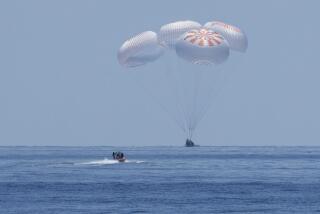Air Guard to Move From Van Nuys to Point Mugu
- Share via
The Pentagon announced Tuesday that the Air National Guard wing now based at Van Nuys Airport will move to the naval air station at Point Mugu, not to the Palmdale-Lancaster area. The announcement followed a two-year lobbying battle over the unit’s transfer.
The decision by the Department of the Air Force came despite appeals from Palmdale and Lancaster city officials to send the unit to their area, and protests from Camarillo city officials that they do not want it at nearby Point Mugu.
Officers of the unit, the 146th Tactical Airlift Wing, argued that Point Mugu would be a better location to attract new recruits and retain the full-time members who keep alive the wing, which depends on volunteers.
Old Site Too Crowded
The Air National Guard unit has been looking for a new home for several years because Van Nuys Airport has become crowded with civilian light planes and the $1-a-year lease the Defense Department had on the Guard’s 62-acre base expired this year. The city set fees of more than $2.6 million a year if the guard does not vacate the site by the end of 1989.
Last month, Guard headquarters in Sacramento hinted that the Air Force was threatening to strip the unit of its federally owned aircraft, effectively disbanding it, if local pressures prevented it from moving to Point Mugu.
But a Pentagon spokesman and an aide to Rep. Bobbi Fiedler (R-Northridge), who represents the Camarillo area, said they knew of no such threat.
Largest U.S. Unit
Camarillo officials complained that the wing would introduce noise, pollution and safety problems into their city. They also complained of the expense to the federal government and loss of farmland if the naval air station buys adjoining fields to house the Air Guard wing, as planned.
The 146th, which has about 360 full-time members and 1,200 “weekend warriors,” is the largest National Guard airlift wing in the nation.
Palmdale and Lancaster officials argued that the drier air in the Mojave Desert would minimize maintenance problems, whereas the salty ocean air at Point Mugu would harm the aircraft. They also said they could offer a less expensive home on an airfield already owned by the Air Force, Air Force Plant 42.
The final decision was made by James F. Boatright, deputy assistant Air Force secretary for installations, environment and safety.
Boatright said the leadership of the California Air National Guard “always favored relocation to Point Mugu” because a move to Palmdale would cause more full-time personnel, “a critical component in maintenance of long-term unit integrity,” to quit.
“I am not inclined to second-guess their judgment,” he said.
He said a second reason for the decision was an agreement between the Air Force and the Los Angeles Department of Airports that makes it undesirable to shift more military units to Air Force Plant 42.
In 1968, Los Angeles bought 17,000 acres in Palmdale for a proposed international airport, which has not been built. The Defense Department has long opposed such an airport, Boatright noted, fearing heavy civilian air traffic would interfere with operations at nearby Edwards Air Force Base.
Recent Agreement
The Air Force and the city’s Department of Airports recently agreed that Los Angeles will turn Air Force Plant 42 into a joint civilian-military airfield, and that the city will not build a new airport on its own land until the airport there is operating at capacity, he said.
Consequently, he said, it is in the interests of the Defense Department to reserve as much space as possible at Air Force Plant 42 for civilian operations, to postpone as long as possible the time when Los Angeles feels the need to build an airport nearby. Air Force Plant 42 is an industrial complex where aerospace firms build or complete aircraft assembly.
Clifton A. Moore, general manager of the Department of Airports, confirmed that such an agreement had been reached. He said it would be submitted for approval today to the Board of Airport Commissioners, which sets policy for the department.
More to Read
Sign up for Essential California
The most important California stories and recommendations in your inbox every morning.
You may occasionally receive promotional content from the Los Angeles Times.













